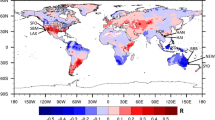Abstract
This study analyzes how the stochastically generated rainfall time series accounting for the inter-annual variability of rainfall statistics can improve the prediction of watershed response variables such as peak flow and runoff depth. The modified Bartlett–Lewis rectangular pulse (MBLRP) rainfall generation model was improved such that it can account for the inter-annual variability of the observed rainfall statistics. Then, the synthetic rainfall time series was generated using the MBLRP model, which was used as input rainfall data for SCS hydrologic models to produce runoff depth and peak flow in a virtual watershed. These values were compared to the ones derived from the synthetic rainfall time series that is generated from the traditional MBLRP rainfall modeling. The result of the comparison indicates that the rainfall time series reflecting the inter-annual variability of rainfall statistics reduces the biasness residing in the predicted peak flow values derived from the synthetic rainfall time series generated using the traditional MBLRP approach by 26–47 %. In addition, it was observed that the overall variability of the peak flow and run off depth distribution was better represented when the inter-annual variability of rainfall statistics are considered.





Similar content being viewed by others
References
Botter G, Settin T, Marani M, Rinaldo A (2006) A stochastic model of nitrate transport and cycling at basin scale. Water Resour Res 42(4):1–15
Chowdhury JU, Stedinger JR, Lu L-H (1991) Goodness-of-fit tests for regional generalized extreme value flood distributions. Water Resour Res 27(7):1765–1776. doi:10.1029/91WR00077
Cowpertwait PSP (1991) Further developments of the Neyman–Scott clustered point process for modeling rainfall. Water Resour Res 27(7):1431–1438
Cowpertwait PSP (1994) A generalized point process model for rainfall. Proc R Soc Lond Ser A 447(1929):23–37
Cowpertwait PSP (1998) A Poisson-cluster model of rainfall: high-order moments and extreme values. Proc R Soc Lond Ser A 454(1971):885–898
Cowpertwait P, Isham V, Onof C (2007) Point process models of rainfall: developments for fine-scale structure. R Soc A Math Phys Eng Sci 463 (2086):2569–2587
Evin G, Favre AC (2012) Further developments of transient Poisson-cluster model for rainfall. Stoch Environ Res Risk Assess 2012:8. doi:10.1007/s00477-012-0612-y
Hosking JRM (1990) L-moments: analysis and estimation of distribution using linear combinations of order statistics. J R Stat Soc Ser B 52:105–124
Kavvas ML, Delleur JW (1975) The stochastic and chronologic structure of rainfall sequences—application to Indiana, Tech. Rep. 57. Water Resources Research Center, Purdue Univ., West Lafayette
Kim D, Olivera F (2012) On the relative importance of the different rainfall statistics in the calibration of stochastic rainfall generation models. J Hydrol Eng 17:368
Kim D, Olivera F, Cho H (2013) Effect of the inter-annual variability of rainfall statistics on stochastically generated rainfall time series: part 1. Impact on peak and extreme rainfall values. Stoch Environ Res Risk Assess. doi:10.1007/s00477-013-0696-z
Koutsoyiannis D, Onof C (2001) Rainfall disaggregation using adjusting procedures on a Poisson cluster model. J Hydrol 246(1–4):109–122
McCuen RH, Wong SL, Rawls WJ (1984) Estimating urban time of concentration. J Hydraul Eng 110(7):887–904
Olsson J, Burlando P (2002) Reproduction of temporal scaling by a rectangular pulses rainfall model. Hydrol Process 16:611–630
Onof C, Wheater HS (1994a) Improved fitting of the bartlett–lewis rectangular pulse model for hourly rainfall. Hydrol Sci J 39:663–680
Onof C, Wheater HS (1994b) Improvements to the modeling of British rainfall using a modified random parameter Bartlett–Lewis rectangular pulse model. J Hydrol 157(1–4):177–195
Onof C, Chandler RE, Kakou A, Northrop P, Wheater HS, Isham V (2000) Rainfall modeling using Poisson-cluster processes; a review of developments. Stoch Environ Res Risk Assess 14:384–411
Rodriguez-Iturbe I, Cox DR, Isham V (1987) Some models for rainfall based on stochastic point processes. Proc R Soc Lond Ser A 410(1839):269–288
Rodriguez-Iturbe I, Cox DR, Isham V (1988) A point process model for rainfall: further developments. Proc R Soc Lond Ser A 417(1853):283–298
SCS (1972) Soil conservation service (SCS), national engineering handbook—sect. 4—hydrology. Department of Agriculture, Washington DC
Acknowledgments
This study was financially supported by the Construction Technology Innovation Program (08-Tech-Inovation-F01) through the Research Center of Flood Defence Technology for Next Generation in Korea Institute of Construction & Transportation Technology Evaluation and Planning (KICTEP) of Ministry of Land, Transport and Maritime Affairs (MLTM). The work of the 1st author (Prof. Dongkyun Kim) was supported by the Hongik University new faculty research support fund.
Author information
Authors and Affiliations
Corresponding author
Rights and permissions
About this article
Cite this article
Kim, D., Olivera, F., Cho, H. et al. Effect of the inter-annual variability of rainfall statistics on stochastically generated rainfall time series: part 2. Impact on watershed response variables. Stoch Environ Res Risk Assess 27, 1611–1619 (2013). https://doi.org/10.1007/s00477-013-0697-y
Published:
Issue Date:
DOI: https://doi.org/10.1007/s00477-013-0697-y




